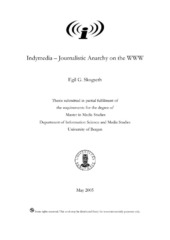| dc.description.abstract | As with all new media technologies, the establishment and growth of the Word Wide Web in the 1990s sparked optimism in civil society. Instead of solely relying on their marginalised existence in mainstream media and/or expensive analogue production and distribution technologies, many of the new direct action orientated groups in the global justice movement formed their own cheap and efficient Web-based news outlets to tell their side of the globalisation story. Indymedia (Independent Media Center – IMC) have since they started in Seattle in 1999 – covering the protests against the World Trade Organization (WTO) – grown to become the largest of these new social movement media projects. The global IMC-network consists of hundreds of volunteers – organisers, activist journalists, and “techies” – in approximately 150 editorial collectives (some of which are inactive) in 48 countries. In addition to this, all collectives’ homepages have an open publishing section (Newswire) which enables everyone with access “to become the media”. From their anarchist point of departure Indymedia question the distinction between journalist and citizen by allowing people to use their homepages as a tool for social change. In order to assess what consequences this strategy has had on Indymedia’s organisational and journalistic praxis, the thesis firstly introduces its four theoretical approaches: globalisation and the network society, media ownership and Internet as an arena to challenge corporate control, the public sphere, and journalism. The discussion of the last two concludes with new normative theories: Publicity for Empowerment and Journalism of Radical Engagement. Secondly, the descriptive part of the thesis introduces Indymedia’s ideological and practical sources of inspiration. This includes socialism, computer hackers, and the Mexican Zapatistas. The next chapter uses Indymedia’s coverage of the protests in Seattle against the elite network WTO as a case study of their focus on events. Finally, sparked by their achievements in Seattle, the development of a global network of autonomous IMC-collectives is evaluated. The first part of the analysis trace the journalistic conventions of Indymedia by evaluating extracts from interviews with Indymedia activists in relation to the ideals set forth in Journalism of Radical Engagement. Based on a short fieldwork, the second part of the analysis is a case study of Indymedia’s coverage of the Word Social Forum in Mumbai in 2004. Using several theoretical approaches (amongst others Publicity for Empowerment) on this coverage of a pro-active global justice movement, the chapter asserts that the international collective produced counter information, which unlike the IMC coverage of Seattle did not manage to break through the infosphere. The thesis concludes that Indymedia for several reasons mostly enable computer literate political activist “to become the media”. Thus, as a participatory media experiment, IMC have a long way to go before they constitute a truly global and democratic network of public spheres. | en_US |
